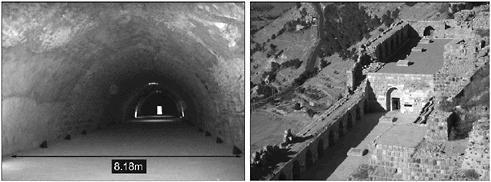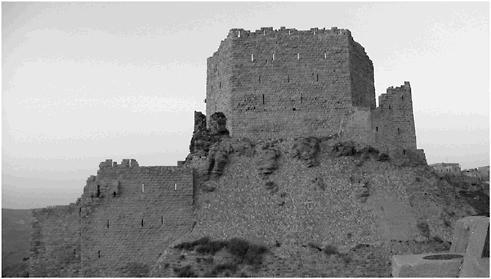Muslim Fortresses in the Levant: Between Crusaders and Mongols (98 page)
Read Muslim Fortresses in the Levant: Between Crusaders and Mongols Online
Authors: Kate Raphael
Tags: #Arts & Photography, #Architecture, #Buildings, #History, #Middle East, #Egypt, #Politics & Social Sciences, #Social Sciences, #Human Geography, #Building Types & Styles, #World, #Medieval, #Humanities

A rectangular tower was built at the southern end of the gallery where the slope is moderate and accessible (
Figure 4.27
). It appears to have been added almost as a second thought. The shot band inscription is no longer legible and has been partially eroded by the weather. The few letters that can still be seen are similar in size and design to the letters in Baybars’ inscription on the southern keep. The addition of galleries reinforced the entire western side, though they were most probably built to provide storage room and/or accommodation for garrison soldiers rather than to enhance the defenses of the fortress, already protected by the steep slope. The government granaries may well have been located in the large vaults, where they were kept in

Figure 4.26
Karak, the Mamluk western galleries with their barrel-shaped vaults

Figure 4.27
Karak, the western entrance into the Mamluk galleries and the oculus above the inner staircase
sacks and fastened with a seal.
202
Before leaving Karak, Baybars himself inspected the granaries ( ,
, ) to see all was in order.
) to see all was in order.
203
Once he left the granaries became the chief responsibility of the fortress governor.
The southern keep
The outer defenses underwent one further change during Baybars’ reign. A large tower was built in the south. Its size and height, the unusual thickness of its external walls and the existence of large cisterns at the base endow it with the qualities attributed

Figure 4.28
Karak, the Mamluk keep. Note the remains of the Frankish towers destroyed during the keep’s construction.
to keeps; though unlike and Safad at Karak it was incorporated in the external curtain wall.
and Safad at Karak it was incorporated in the external curtain wall.
Ibn Shaddād adds a few more details; in his he says that Baybars built up (
he says that Baybars built up (
shayyada
) the fortress and made it stronger. The moat was dug out, probably meaning cleaned rather than made deeper. He then writes that he, i.e the Sultan, encircled the fortress, using the verb which literally means to surround, encompass or enclose.
which literally means to surround, encompass or enclose.
204
The version given by Ibn Shaddād in the
Ta’rīkh al-malik is quite different.
is quite different.
[He i.e Baybars] renewed in the fortress two small towers. [First he] destroyed them and then made them larger and higher. Then he dug the moat and made it more sinuous.
This description fits the archaeological evidence. The Mamluk keep was built on the basis of two Frankish towers that guarded the south. The remains of the Frankish towers with their black stones can still be seen below the mamluk keep (
Figure 4.28
). The Mamluk keep has an unusual shape due to the limited space available at the southern edge of the spur. It is a long and narrow rectangle with cut corners (length 37m, width 16m). The most interesting feature of this structure is its outer walls, measuring 6m, almost two and a half times the thickness of the original Frankish curtain walls.
This keep has thee floors with an additional open surface at the top. The arrow slits are placed alternately. The upper floors have a denser line of arrow slits than the

